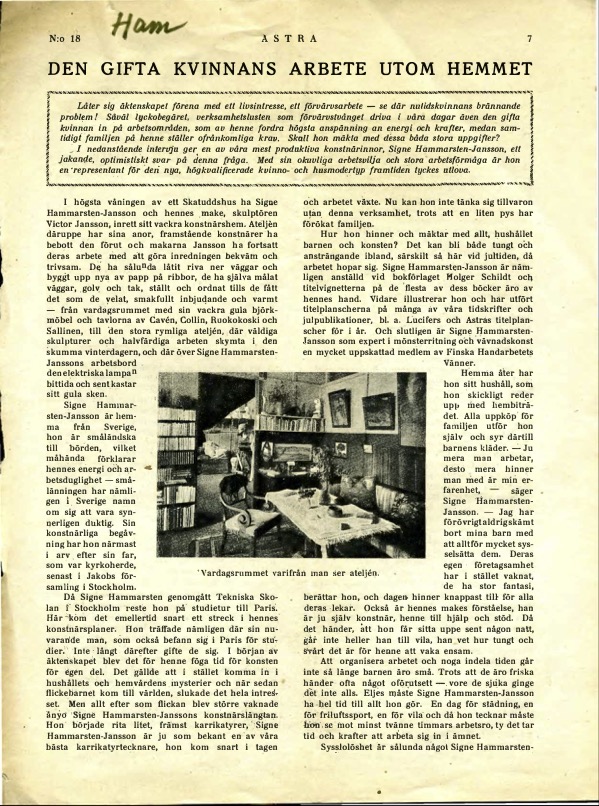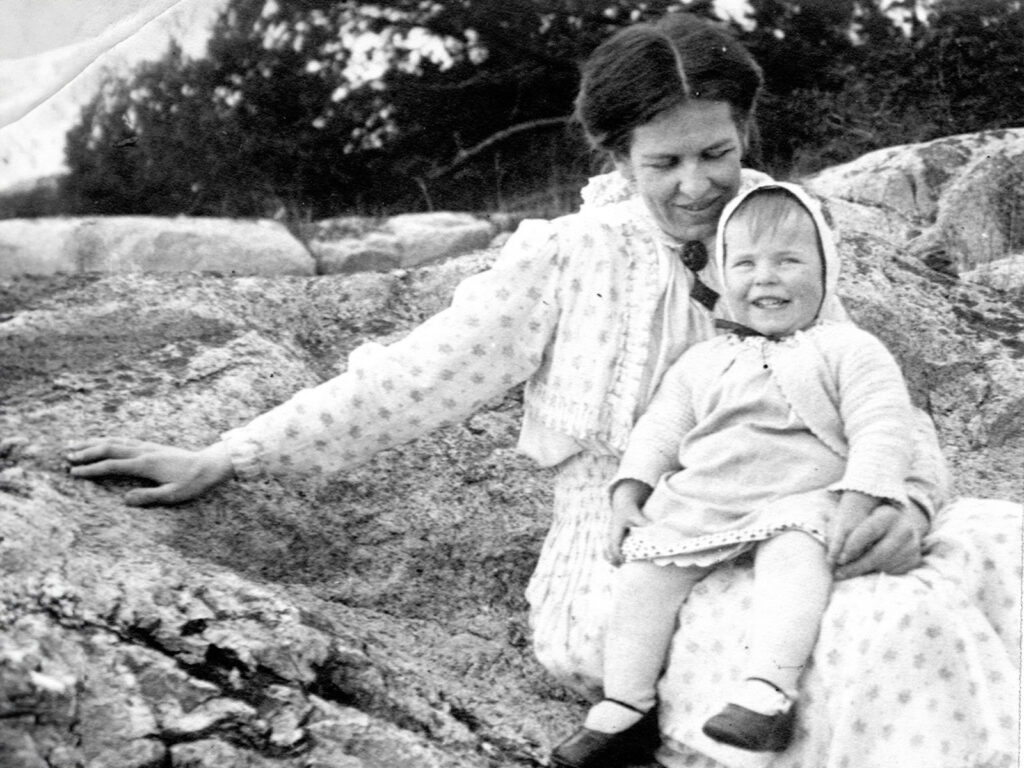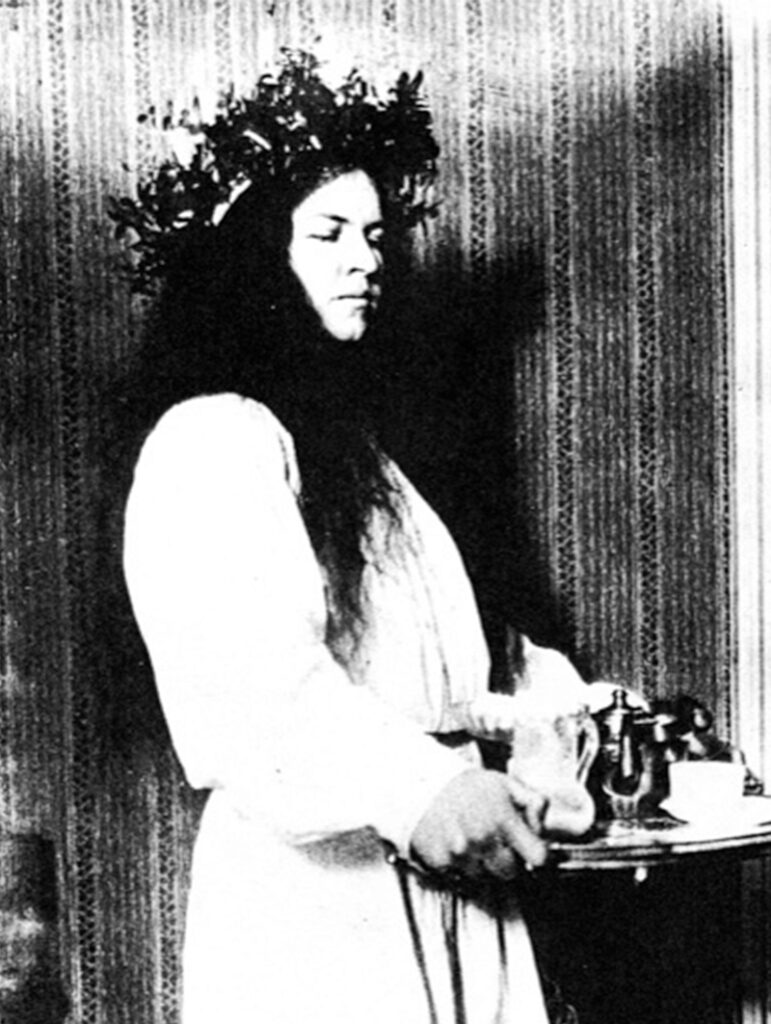
Tove Jansson’s mother in a unique interview from 1922: “It would be terrible not to have your own money”

In 1922, the feminist magazine Astra visited the Jansson family home, where Tove’s mother Signe Hammarsten Jansson, one of Finland’s most prominent illustrators at the time, was interviewed about combining work and family. “How does she manage everything, the household, the children and the art?” asks the journalist. “The more you work, the more you can do, in my experience”, is Hammarsten Jansson’s reply.
Astra’s 1922 article begins with a rhetorical question that still resonates more than 100 years later, when many are struggling to juggle career and family life:
“Can marriage be reconciled with an important interest, an occupation? That’s the dilemma of the modern woman! […] Can she manage these two major undertakings? In the following interview, one of our most productive female artists gives an affirmative, optimistic answer to this question.”

A home adorned with sculptures and half-finished works
Writer Märta Schultz-Cajander begins her interview with Tove Jansson’s mother with a delightful description of the Jansson artist’s atelier home in the Katajanokka district in Helsinki.
Many prominent artists had lived in the atelier before the Janssons, who have strived to create a comfortable and cosy home.
“They have thus had the walls torn down and built new ones of cardboard on ribs, they have painted the walls, floors and ceilings themselves, arranged and rearranged until they got what they wanted, tastefully inviting and warm – from the living room with its beautiful yellow birch furniture and the paintings by Cavén, Collin, Ruokokoski and Sallinen, to the large spacious studio, where huge sculptures and half-finished works are visible in the dusky winter day, and where over Signe Hammarsten Jansson’s work table the electric lamp casts its yellow glow from the break of morn until the twilight hours.”

The Swedish work ethic of Tove Jansson’s mother
Signe Hammarsten Jansson’s productivity is a recurring subject in the interview.
“With her indomitable will to work and great capacity, she is a representative of the new, highly skilled kind of woman and housewife the future seems to promise.”

 In the interview, Tove Jansson’s mother Signe Hammarsten Jansson does not mention one of her great youthful interests – scouting, which she helped introduce in Sweden.
In the interview, Tove Jansson’s mother Signe Hammarsten Jansson does not mention one of her great youthful interests – scouting, which she helped introduce in Sweden.The journalist notes that Signe Hammarsten Jansson, whom she calls “one of our country’s most productive female artists“, is originally from Småland “which perhaps explains her energy and ability to work – the Smålanders have a reputation in Sweden for being particularly skilful“.
The article describes how Signe Hammarsten Jansson, after graduating from the Technical School in Stockholm, studied in Paris, where “there was a dent in her artistic plans”. She married the sculptor Viktor Jansson, whom she had met in Paris, and after she became pregnant, they moved to his home city, Helsinki.
“The infant consumed her interest”
“At the beginning of her marriage, she had little time for her own art. Instead, she had to get involved in the mysteries of the household, and when the infant girl was born, she consumed all her interest. But as the girl grew, Signe Hammarsten Jansson’s desire to be an artist arose anew.”

 Tove Jansson in the arms of her mother Signe Hammasten Jansson.
Tove Jansson in the arms of her mother Signe Hammasten Jansson.“As you know, Signe Hammarsten Jansson is one of our best illustrators,” Schultz-Cajander states.
“Now she can’t imagine life without this activity, even though another little one has joined the family.”
Christmas means more work
Signe Hammarsten Jansson has a busy life. Especially at Christmas time, work can pile up.
In the early 1920s, she was responsible for most of the covers for the book publisher Holger Schildt, and at the same time, she drew covers and illustrations for many Christmas publications and magazines, including Lucifer and Astra, the magazine where Jansson is being interviewed.
Hammarsten Jansson is also a valued member of the Friends of Finnish Handicraft – she is recognised as an expert in pattern drawing and weaving.
She has a maid to help with the housework, but does all the shopping and sews the children’s clothes herself.

 This illustration by Signe Hammarsten Jansson called “A Housewife from Helsinki” depicts herself and Tove doing groceries.
This illustration by Signe Hammarsten Jansson called “A Housewife from Helsinki” depicts herself and Tove doing groceries.How does she have time for everything?
“How does she manage to do everything: the household, the children and art?”, the writer asks.
“The more you work, the more you get done, is my experience” replies Signe Hammarsten Jansson.
Ham did not want to spoil her children with activities
Tove Jansson’s mother also has a parenting principle which probably helped fuel her daughter’s imagination at an early age:
“I have never spoilt my children by keeping them too busy. Instead, their own enterprise spirit has been awakened, they have great imagination”, she says, “and there is hardly enough time in the day for all their games”.
The journalist notes that Signe Hammarsten’s artist husband, sculptor Viktor Jansson, supports her irregular working hours.
“When she has to stay up late some night, he doesn’t go to sleep either, he knows how heavy and difficult it is for her to stay up alone.”
“I am happiest when I can use all my strength”
Signe Hammarsten Jansson’s experiences of trying to work with young children in the house are easy to reflect on a hundred years later. She believes it is impossible to divide time carefully while the children are young. Even if they are healthy, ‘something unforeseen often happens’, and if they are sick, it is not possible at all.”
One day for cleaning, one for outdoor sports, one for rest
But otherwise, Signe Hammarsten Jansson says she needs “full time” for everything she does:
“One day for cleaning, one for outdoor sports, one for rest – and when she draws she must look forward to at least two hours of peace and quiet, because it takes time and energy to dive into a subject.”
Signe Hammarsten Jansson doesn’t seem to be idle very often.
“I’m happiest“, she says, “when I can use all my strength“.

 Signe Hammarsten Jansson also made time for outdoor activities.
Signe Hammarsten Jansson also made time for outdoor activities.A passion for family and work
Writer Märta Schultz-Cajander paints a moving picture of a hard-working professional woman who loves her family, but who also loves her work and art, which she could not live without.
Signe Hammarsten Jansson also managed to combine the two in a way that was unusual for her time.
“She tenderly caresses her little boy and says: My husband, my children naturally take precedence over everything else, even art – but at the same time, she admits that she could not live without it.”
‘It would be terrible not to have your own money’
The article describes how Hammarsten Jansson needs her family, “the personal happiness among her own“, to be able to create. But she also works to support her family, and this is where the purely economic and socio-political side comes in.
“In an artist’s family, it is impossible for the man to carry the financial burden alone in these times“, the journalist observes.
Signe Hammarsten Jansson is happy to help.
“It would be terrible – she says – not to have your own money: it gives one a completely different position in the home.”

Tove Jansson’s mother as Lucia
Signe Hammarsten Jansson says that although switching from working as an artist to working at home can be exhausting, it can also be refreshing.
Journalist Märta Schultz-Cajander ends the article by describing how Signe Hammarsten Jansson bids her farewell with a warm smile and a radiant look. This makes the journalist think about how beautiful Hammarsten Jansson must be as a candle-lit Lucia, something Hammarsten Jansson has talked about in the interview, which takes place in the weeks leading up to Christmas.
It turns out that Signe Hammarsten Jansson has brought an important Christmas tradition from her childhood home in Sweden:
“… on Christmas Eve morning, she dresses as Lucia, in white with a wreath of green and lights in her hair, and with a coffee tray full of yule delicacies, she wishes her family a Merry Christmas“.
You can read more about Christmas in the Jansson family in this article.










